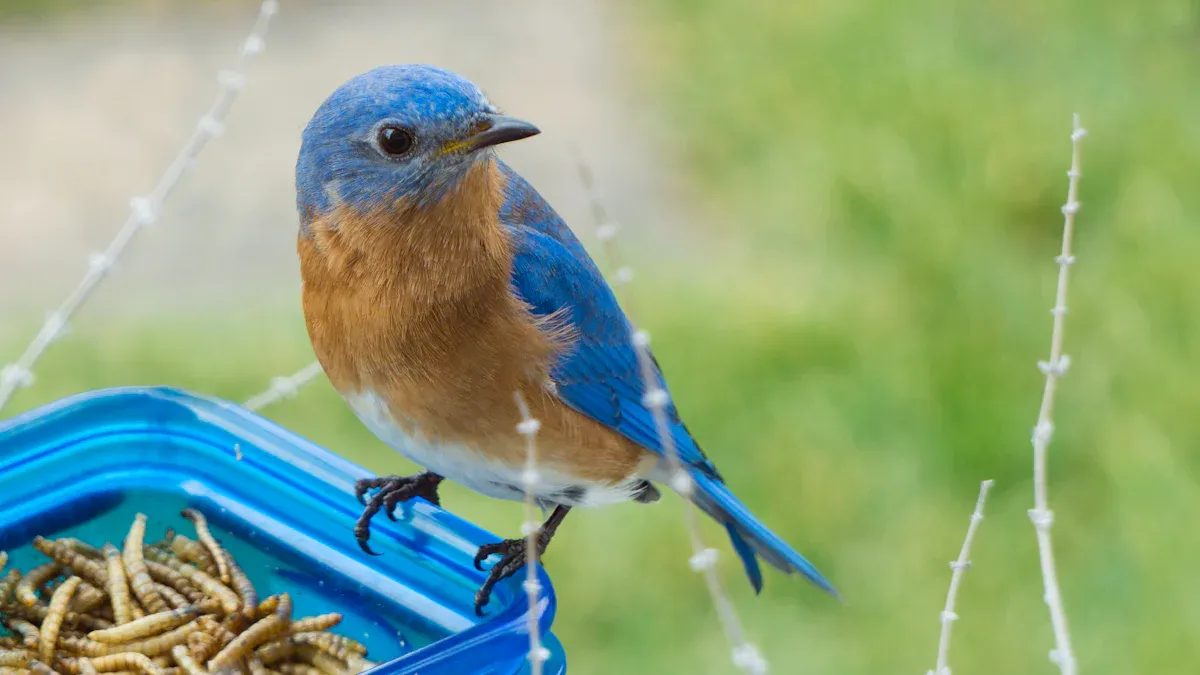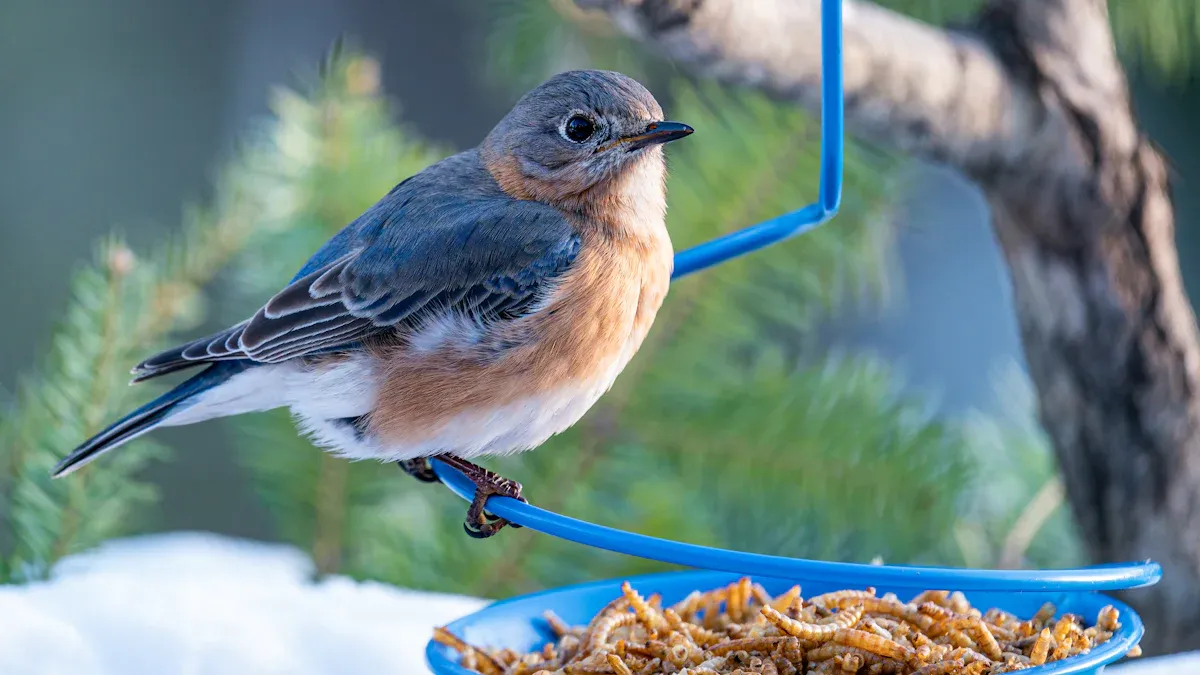
When feeding wild birds mealworms, you face a choice between live and dried options. Live mealworms provide superior nutrition and hydration, making them ideal during breeding seasons. Dried mealworms, on the other hand, offer convenience and affordability. Your decision depends on factors like the bird species in your area and the time of year.
Key Takeaways
- Live mealworms give more nutrients and water. They are great during breeding seasons and attract more birds because they move.
- Dried mealworms are easier to use and cost less. Soaking them in water makes them more appealing and adds moisture back.
- Think about what different birds need and the time of year when picking live or dried mealworms. Using both can help keep birds healthy all year.
Feeding Wild Birds Mealworms: An Overview
Why mealworms are a popular choice for wild birds
Mealworms have become a favorite food for many bird enthusiasts. These protein-packed insects closely resemble the natural diet of wild birds, making them an excellent choice. Birds like robins, bluebirds, and wrens find mealworms irresistible due to their texture and taste. You can use mealworms to attract a variety of species to your yard, creating a lively and diverse birdwatching experience.
Another reason mealworms are so popular is their versatility. You can offer them in different forms, such as live or dried, depending on your preference and the needs of the birds. Live mealworms mimic the movement of insects in the wild, which excites birds and encourages feeding. Dried mealworms, on the other hand, are easy to store and handle, making them a practical option for many bird lovers.
The role of mealworms in a bird’s diet
Mealworms play a vital role in supporting the health of wild birds. They are rich in protein, which is essential for muscle development and energy. During the breeding season, mealworms provide the nutrients needed for egg production and feeding hungry chicks. Young birds benefit greatly from the high protein content, as it helps them grow strong and healthy.
For adult birds, mealworms serve as a quick energy source, especially during migration or colder months. While mealworms should not replace a bird’s natural diet, they act as a valuable supplement. By feeding wild birds mealworms, you help them thrive in challenging conditions and support their overall well-being.
Nutritional Comparison of Live and Dried Mealworms

Protein, fat, and moisture content
Live mealworms contain higher levels of moisture compared to dried ones. This moisture is essential for hydration, especially during warmer months. Live mealworms typically consist of about 20% protein, 13% fat, and 62% water. In contrast, dried mealworms lose most of their water content during the dehydration process. They retain approximately 53% protein and 28% fat, making them a more concentrated source of nutrients. However, the lack of moisture in dried mealworms means birds may need additional water sources when consuming them.
Nutritional benefits for young vs. adult birds
Young birds benefit greatly from the hydration and protein found in live mealworms. These nutrients support their rapid growth and development. For adult birds, dried mealworms provide a quick and energy-dense snack. This makes them ideal during migration or colder months when energy demands are higher. When feeding wild birds mealworms, consider the age and needs of the birds in your area. Live mealworms are better for chicks, while dried ones suit adult birds needing a calorie boost.
How dehydration affects nutrient quality
Dehydration preserves mealworms but reduces their overall nutrient quality. The drying process removes water, which can also lead to a slight loss of vitamins and minerals. While dried mealworms remain a good source of protein and fat, they lack the freshness and hydration of live ones. To compensate, you can soak dried mealworms in water before offering them to birds. This rehydration makes them more appealing and restores some of their lost moisture.
Bird Attraction: Live vs Dried Mealworms

Why live mealworms are more appealing to wild birds
Live mealworms grab a bird’s attention because of their movement. The wriggling motion mimics the behavior of insects in the wild, triggering a bird’s natural hunting instincts. When you offer live mealworms, birds see them as a fresh and nutritious food source. This makes live mealworms especially effective for attracting insect-eating species like bluebirds, wrens, and robins. Their high moisture content also provides hydration, which is crucial during hot weather or breeding seasons. If you want to create a lively feeding area, live mealworms are an excellent choice.
Making dried mealworms more attractive
Dried mealworms lack the movement of live ones, but you can still make them appealing to birds. Soaking dried mealworms in water is a simple way to rehydrate them. This process restores some of their moisture, making them softer and easier for birds to eat. You can also mix dried mealworms with other bird favorites, such as seeds or suet. Placing them in a visible and accessible feeder increases the chances of birds noticing and trying them. With a little effort, you can make dried mealworms a valuable addition to your feeding routine.
Seasonal preferences for live and dried mealworms
Birds may prefer live or dried mealworms depending on the season. During spring and summer, live mealworms provide the hydration and nutrients needed for breeding and raising chicks. In colder months, dried mealworms become a practical option. They offer a concentrated energy source when natural food is scarce. By adjusting your approach based on the season, you can ensure that feeding wild birds mealworms meets their changing needs throughout the year.
Practical Considerations for Feeding Wild Birds Mealworms
Cost comparison of live and dried mealworms
When deciding between live and dried mealworms, cost plays a significant role. Live mealworms are generally more expensive due to their need for careful handling and storage. You may find that their higher price reflects their nutritional value and appeal to birds. Dried mealworms, on the other hand, are more budget-friendly. They come in bulk packages, which can last longer and reduce overall costs.
If you’re feeding wild birds mealworms regularly, dried options might be more economical. However, live mealworms could be worth the investment during breeding seasons when birds need extra hydration and nutrients. Balancing cost with the needs of your local bird population can help you make the best choice.
Storage and maintenance requirements
Live mealworms require specific conditions to stay healthy. You’ll need a cool, dry place to store them, such as a refrigerator. Regular feeding and cleaning of their container are also necessary to prevent spoilage. Dried mealworms, in contrast, are much easier to store. They come in sealed packages and don’t require refrigeration.
For convenience, dried mealworms are the better option. Live mealworms, however, demand more effort but offer greater benefits for birds during critical times.
Ease of use and feeding methods
Dried mealworms are simple to use. You can scatter them on the ground, mix them with seeds, or place them in a feeder. Live mealworms require more care. You’ll need a smooth-sided container to prevent them from escaping. Birds may take time to recognize dried mealworms as food, but live ones are instantly appealing due to their movement.
If you’re new to feeding wild birds mealworms, starting with dried ones might be easier. As you gain experience, you can experiment with live mealworms to attract more species.
Environmental Impact of Live and Dried Mealworms
Sustainability of mealworm farming
Mealworm farming has gained attention as an eco-friendly option for feeding wild birds. Compared to traditional livestock farming, mealworms require fewer resources. They consume less water, land, and feed, making them a sustainable protein source. If you care about reducing your environmental footprint, mealworms are a great choice.
Mealworms also produce minimal greenhouse gases. Unlike cattle or poultry, they emit almost no methane. This makes their farming process more climate-friendly. Additionally, mealworms can thrive on organic waste, such as vegetable scraps. By supporting mealworm farming, you contribute to a system that recycles waste into valuable food for birds.
However, sustainability depends on farming practices. Look for suppliers who prioritize ethical and eco-conscious methods. Some farms use renewable energy or avoid harmful chemicals. Choosing these options ensures your bird-feeding habits align with environmental values.
Waste and spoilage concerns
Feeding wild birds mealworms comes with waste and spoilage risks. Live mealworms can die if stored improperly. Dead mealworms spoil quickly, creating unpleasant odors and attracting pests. To avoid waste, store live mealworms in a cool, dry place and feed them regularly.
Dried mealworms have a longer shelf life but can still go bad if exposed to moisture. Always keep them in sealed containers to maintain freshness. If you notice mold or an off smell, discard them immediately.
Tip: Buy mealworms in quantities you can use within a reasonable time. This reduces waste and ensures birds get fresh, nutritious food.
By managing storage and usage carefully, you minimize spoilage and make the most of your mealworm supply.
Live mealworms offer better nutrition and hydration, making them ideal for breeding seasons. However, they require more effort to store and handle. Dried mealworms are easier to use and more affordable but lack moisture.
Tip: Combine live and dried mealworms to meet the needs of different bird species and seasons. This balanced approach ensures you provide the best care for wild birds.
FAQ
Can you feed wild birds only mealworms?
No, mealworms should supplement a bird’s diet. Birds need a variety of foods, including seeds, fruits, and insects, to meet their nutritional requirements and stay healthy.
How many mealworms should you feed birds daily?
Feed birds a small handful of mealworms daily. Overfeeding can lead to dependency. Adjust the amount based on the number of birds visiting your feeder.
Are dried mealworms safe for all bird species?
Yes, most bird species can safely eat dried mealworms. However, insect-eating birds like bluebirds and robins benefit the most from their high protein and fat content.
Tip: Always provide fresh water alongside mealworms to keep birds hydrated and healthy.


